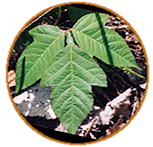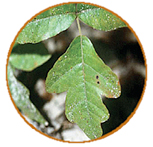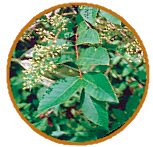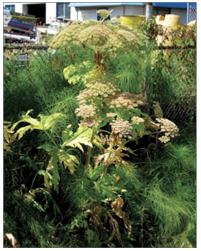Landscaping - Poisonous Plants
On this page
- Are there poisonous plants in Canada?
- Who is at risk of exposure to poisonous plants?
- How can I identify these plants?
- What is the concern when working near or with poison ivy, oak, or sumac plants?
- How do I treat exposed skin (poison ivy, oak, or sumac plants)?
- What is the concern about giant hogweed?
- How is exposure to giant hogweed treated?
- What prevention steps can be taken for all poisonous plants?
Are there poisonous plants in Canada?
Back to topYes. While many plants are classified as poisonous, this document will discuss four common plants found in Canada. Note that the same prevention and treatment steps may apply when working with other plants.
Poisonous plants that commonly cause allergic reactions include poison ivy, poison oak, and poison sumac. Giant hogweed can cause severe burns and possibly blindness.
Poison ivy is found across Canada, poison oak is found in western Canada (British Columbia), and poison sumac is found in central and eastern Canada. Giant hogweed is a recent invasive species that has been found in many provinces across Canada.
Who is at risk of exposure to poisonous plants?
Back to topWorkers at risk include farmers, foresters, landscapers, groundskeepers, gardeners, arborists, outdoor painters, construction and road workers, labourers, and any other workers, such as camp or recreational workers, who spend time outside near vegetation. Also at risk are forestry workers and firefighters who may fight forest fires, as there is an increased risk of injury from inhalation exposure when the plants burn.
How can I identify these plants?
Back to topPoison ivy: Poison ivy is typically a vine or shrub with three leaves close together. The leaves are green and turn red in the fall. There are small yellow or green flowers which later turn into small berries that are white, green or yellow.

Image 1 (above): Poison ivy (Image from NIOSH/US Dept. of Agriculture)
Poison oak: Poison oak is typically a shrub with three leaves close together. Pacific poison oak can be vine-like. There are small yellow or green flowers, which later turn into green-yellow or white berries.

Image 2 (above): Poison oak (Image from NIOSH/US Dept. of Agriculture)
Poison sumac: Poison sumac is a woody shrub that has leaves with stems containing 7 to 13 leaves. The leaves are arranged mostly in pairs. Berries may be glossy and pale yellow to cream coloured.

Image 3 (above): Poison sumac (Image from NIOSH/US Dept. of Agriculture)
Giant hogweed (giant cow parsnip): Giant hogweed is a very large perennial plant. It has large leaves up to a metre across, and stalks that can reach 6 metres tall in height. As a young plant, it may be mistaken for less hazardous wild parsnip. It has white-yellow flowers that are usually in a large cluster up to a metre across.

Image 4 (above): Giant hogweed (Image from WorkSafeBC)
What is the concern when working near or with poison ivy, oak, or sumac plants?
Back to topThe leaves or other parts of these plants contain an oil that, when it touches your skin or eyes, will usually cause a reaction ranging from irritation (mild itchiness and redness) to an allergic reaction. This reaction is called allergic contact dermatitis. Most exposed people will have an itchy red rash with blisters. Some may experience respiratory symptoms (such as difficulty breathing) and fevers. In some cases, a reaction may not occur with the first exposure, but the person may become sensitized and will react to further exposures.
Typical signs and symptoms include:
- Swelling and itching of the skin.
- A red rash within a day or two of contact.
- Blisters or bumps may appear, and the blisters may weep or ooze.
Indirect contact may occur, such as when bare skin touches gloves or clothes that have been in contact with the plants. Care must be taken when removing gloves or clothing. Also, do not touch your face or skin while working.
If these plants are being burned, inhalation of the burning oil in the plant can cause lung irritation and difficulty breathing.
How do I treat exposed skin (poison ivy, oak, or sumac plants)?
Back to topIf you believe you have been in contact with a poisonous plant, immediately wash the affected area with dishwashing or other degreasing soap and a lot of water. Be sure to scrub under fingernails or toenails with a scrub brush and soapy, cool water. If soap is not available, vinegar (30 mL (2 tablespoons) in 227 mL (1 cup) of water) or alcohol (113 mL (1/2 cup) in 113 mL (1/2 cup) of water) can be used.
If symptoms appear:
(Note: Only use medications with the advice of a doctor or medical professional.)
- Call 911 immediately
, and go to a hospital emergency room if you experience there are severe reactions such as swelling of the throat and face or difficulty breathing. - Get help from a medical professional in severe skin cases or if the rash is on your face.
- Apply cool compresses, calamine lotion, or anti-itch creams such as hydrocortisone to unbroken skin.
- Try a cool bath, sprinkling the bath water with baking soda, uncooked oatmeal
, or colloidal oatmeal may reduce itchiness. - Take an antihistamine to relieve itchiness, but be aware that this medication may cause drowsiness.
What is the concern about giant hogweed?
Back to topContact with the sap of giant hogweed in the stalk, stems, or leaves can cause serious burns or blindness. The reaction is due to light-sensitive chemicals in the sap. The reaction can occur in less than 15 minutes, but it may take many hours for the symptoms to appear. Concerns include:
- Skin contact will cause irritation and burning with redness and blisters.
- Affected skin and eyes will become inflamed and swollen up to two or three days later.
- Eye contact will cause pain and may result in temporary or permanent blindness.
- Skin may darken (pigmentation), which lasts for months or years.
- Light sensitivity may continue for months or years.
- Permanent scarring is possible.
How is exposure to giant hogweed treated?
Back to topIf you believe you have been exposed to giant hogweed, contact a doctor or medical professional immediately. Also:
- Wash the affected area with dishwashing or other degreasing soap and plenty of cool water.
- Scrub under nails with a scrub brush and soapy water.
- If the eyes are affected, flush with copious amounts of water and wear ultraviolet (UV) protective sunglasses.
- Keep away from all sunlight for at least 48 hours.
Note that affected areas will need to be protected from sunlight using sunglasses or UV protective creams (e.g., sunblock cream) for months and possibly for years.
What prevention steps can be taken for all poisonous plants?
Back to topEducate and train workers to know:
- How to recognize poisonous plants.
- How they might be exposed.
- How to prevent exposure, including how to avoid the plants, how to clean tools, and how to put on and remove personal protective equipment (PPE).
- What to do if they are exposed.
Prevent exposure by:
- Wearing protective clothing, including eye protection, long sleeves, long pants, boots, and gloves:
- When handling giant hogweed, also wear protective goggles and make sure that the clothing is water-resistant and thick enough to resist the thorny stalks (for example, heavy rubber gloves and water-resistant coveralls).
- Making sure that protective clothing is removed carefully to avoid indirect contact.
- Washing work clothes separately in detergent with hot water and hanging them outside for several days. Treat all clothing as if it has been contaminated.
- Avoiding the use of string trimmers which can spray sap or leaves widely (especially when trimming giant hogweed).
- Using soap and water to wash hands and skin.
- Cleaning surfaces with rubbing alcohol or soap and water, such as camping gear, gardening tools, and sporting equipment, if contact with a poisonous plant is suspected.
Do not burn poisonous plants. Inhaling the smoke can lead to severe respiratory problems. If burning the plants is necessary, the National Institute for Occupational Safety and Health (NIOSH) recommends the following:
- A NIOSH-certified half-face piece particulate respirator rated R95, P95, or better. This recommendation does NOT apply to wildland firefighters, who may require a higher level of protection.
- These respirators should protect against exposure to burning poisonous plants, but will not protect against all possible combustion products in smoke, such as carbon monoxide.
If workers need to use a respirator, then a respiratory protection program is necessary. The program should include the following procedures for:
- Selection and use of respirators.
- Respirator user training.
- Respirator fit testing.
- Inspecting, cleaning, maintaining and storing respirators.
Other OSH Answers documents, such as Designing an Effective PPE Program, Respirator Selection, and Respirator Care, provide additional information that will assist in setting up a respiratory protection program.
- Fact sheet first published: 2017-05-15
- Fact sheet last revised: 2025-06-30

